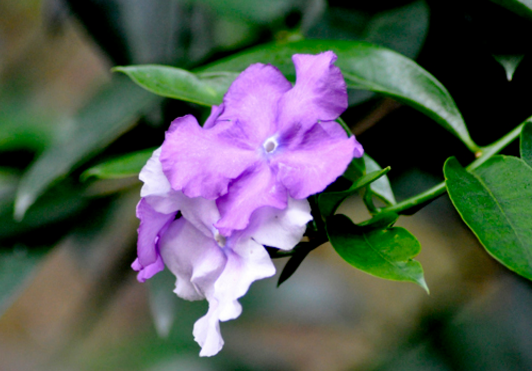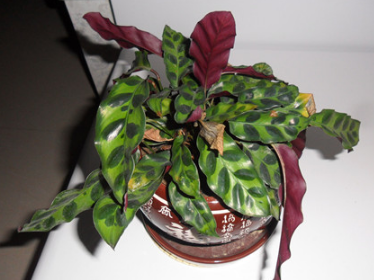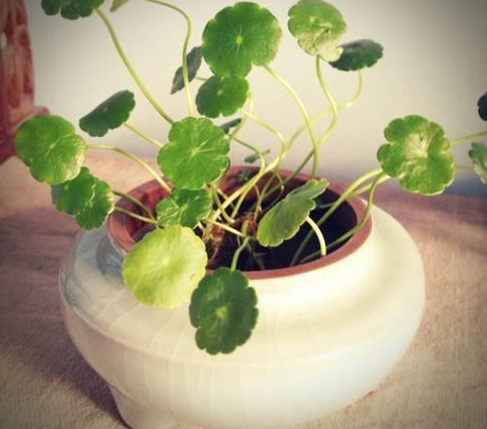What is the effect of the two-color jasmine cutting method?
There is a pot of two-color jasmine at home, it is rather lonely! The second child has been let go, put a few more pots of flowers and plants on your balcony, accompany each other, the flowers will grow healthily. You don't want to see the strange landscape of one flower and two colors.

Cutting method of two-color jasmine
1. Cutting soil of bicolor jasmine.
Cutting two-color jasmine commonly used nutrient soil, river sand, peat soil and other materials, because it is difficult to obtain ideal soil in the family, it is recommended that we buy sterilized cutting substrate, for novice cuttings, can improve the survival rate.
It is also possible to choose ordinary coarse river sand, but rinse with clean water before use. Sea sand and saline-alkali soil should not be used as far as possible, which will affect the rooting of branches.
2. Branch selection of bicolor jasmine
Generally, young twigs are selected for cutting. the plants grow vigorously in early spring or early autumn, and the branches of the current year are cut as cuttings. When cutting branches, note that the upper cut is about 1 cm away from the top leaf, and the lower cut is about 0.5 cm from the lower leaf, not too close to the branches and leaves, so as not to affect the rooting and sprouting in the later stage.
3. Cutting method of two-color jasmine.
Before cutting, wet the soil, then according to the number of branches, dig the same amount of small holes in the soil surface, put the branches into them, cover the soil, compact, and be careful not to break the branches in the operation. Then pour through the water, maintain a certain degree of humidity, can be covered with plastic film to moisturize.
4. After cutting of two-color jasmine
After cuttage, it is difficult to control the temperature at 20: 30 ℃, and it is difficult to take root below 20 ℃. If it is higher than 30 ℃, the incision is easy to be infected, and the higher the temperature is, the greater the probability of decay is. If you encounter low temperature after cutting, you should take good measures to keep warm.
Spray moisturizing in time, 3-5 times a day, and increase the number of times when it is sunny. For those who are covered with plastic film to moisturize, uncover the plastic film and breathe every day.
Cutting is also inseparable from sunlight, sufficient sunshine is conducive to the accumulation of nutrients. However, the more abundant the sun is, the higher the temperature is, so it is necessary to shade in time and gradually restore the light after taking root.
What's the use?
1. The ornamental effect of bicolor jasmine.
The two-color jasmine is colorful and fragrant, so it has high ornamental value. It can also be made into potted plants to watch in gardens and scenic spots. More importantly, two-color jasmine conservation and reproduction is simple, breeding at home, usually it can be placed on the balcony, windowsill or corridor, can play a good role in beautification.
2. Purification effect of bicolor jasmine.
Two-color jasmine is very suitable for family planting. Although the flowers are small, they have a strong fragrance, adding a hint of fragrance to your room. In addition, two-color jasmine respiration can absorb carbon dioxide and other harmful gases in the air, release oxygen needed by the human body, and play a role in purifying the air. Although the purifying effect cannot be detected by the human eye, the body cannot lie.
3. The particularity of bicolor jasmine
Two-color jasmine is a kind of evergreen flowers with a height of 50 cm to 100 cm. Potted plants can control the plant type at about 40 cm, and the flower has a single branch and a flower. The Corolla of bicolor jasmine has a unique high butterfly shape and has a long flowering period. it blooms from April to October and the opening time of a single flower is about 5 days.
Two-color jasmine is purplish blue at first, slowly turns to snow blue, and finally becomes white. The gradual change of flower color is also the special feature of two-color jasmine.
After reading all this, the editor still feels that the strangest thing about this plant is its "face change".
The culture method of two-color jasmine what is the function of two-color jasmine
Nowadays, people like to raise all kinds of plants at home, which can not only beautify the environment and edify sentiment, but also play a unique role in home decoration. At present, there are more plants suitable for home breeding, and two-color jasmine is one of them. Two-color jasmine is a valuable breed. Isn't it strange to see two different colors of flowers on the same plant? Of course, the breeding of two-color jasmine is not easy, after all, what are the breeding methods of two-color jasmine? What is the use of bicolor jasmine? Let's go with the editor to get to know it.
Culture methods of two-color jasmine:
When it comes to the breeding methods of two-color jasmine, in general, indoor plants should pay special attention to their soil, temperature, light, watering, fertilization, pruning and so on. Let's take a look at the following detailed introduction:
1. Soil requirements:
Two-color jasmine is generally cultivated in East China and North China, which is suitable for slightly acidic soil with good drainage and air permeability.
2. Light and temperature requirements:
The suitable temperature for the growth of bicolor jasmine is 20-30 ℃. At this temperature, the branches and leaves are luxuriant and the growth is vigorous. When the temperature drops to 12 ℃, it warms up and enters the dormant period, which is not cold-resistant. Pay attention to timely indoor maintenance in winter to avoid frostbite.
Two-color jasmine likes sunny, moist environment, avoid scorching sun exposure, summer needs appropriate shade. Too much sun exposure, flowers and leaves are easy to curl. The light time should not be less than 4 hours a day, which can ensure blooming and luxuriant.
3. Watering method:
Two-color jasmine likes to be moist and afraid of waterlogging. Watering should adhere to the principle of seeing dry and wet. Watering in summer should not only meet the needs of plant growth, but also keep the air moist. Spray fresh water to the leaves 2-3 times a day, keep the basin soil dry in winter and prevent frostbite.
4. Fertilization methods:
It is necessary to irrigate alum fertilizer and water in time during the growing period, which can not only prevent soil Alkalization and leaf yellowing, but also increase soil fertility and promote plant growth. After the two-color jasmine flowers withered, a thin cake fertilizer was applied, and 10 days later, a liquid fertilizer based on phosphorus and potassium fertilizer was applied, and combined with watering, potassium dihydrogen phosphate solution was sprayed to the leaves to promote the differentiation of flower buds.
5. Pruning:
In peacetime maintenance, the yellowed and withered leaves should be cut off in time to avoid affecting the ornamental quality of the whole. After the flowers fade, cut off the residual flowers in time, and cut off the branches 1-3-1-2, and cut off the weak branches, introverted branches, disease and insect branches at the end of autumn to ensure that the two-color jasmine will grow vigorously in the coming year.
Such as the above is a brief introduction to the breeding methods of two-color jasmine. I believe that through the above introduction, we will have a further understanding and understanding of the culture of two-color jasmine. Of course, like other indoor plants, two-color jasmine also has some of its own functions. What is the role of two-color jasmine? Let's take a look at the following introduction:
What is the use of bicolor jasmine:
1. The ornamental function of bicolor jasmine:
The two-color jasmine is colorful and fragrant, so it has high ornamental value. It can also be made into potted plants to watch in gardens and scenic spots. More importantly, two-color jasmine conservation and reproduction is simple, breeding at home, usually it can be placed on the balcony, windowsill or corridor, can play a good role in beautification.
2. The purification effect of two-color jasmine:
Two-color jasmine is very suitable for family planting. Although the flowers are small, they have a strong fragrance, adding a trace of fragrance to your room. In addition, two-color jasmine respiration can absorb carbon dioxide and other harmful gases in the air, release oxygen needed by the human body, and play a role in purifying the air. Although the purification effect can not be detected by the human eye, the body cannot lie.
3. The particularity of bicolor jasmine:
Bicolor jasmine is a kind of evergreen flower with a height of 50-100 cm. The plant type can be controlled at about 40 cm in potted plants. The flower has a single branch and a flower. The Corolla of bicolor jasmine has a unique butterfly shape with long flowering period. It blooms from April to October. The opening time of single flower is about 5 days. When bicolor jasmine blooms, it is purplish blue at first, slowly turns into snow blue, and finally becomes white. The gradual change of flower color is also the special feature of bicolor jasmine.
Cutting method of two-color jasmine
Cutting soil of bicolor jasmine
Cutting two-color jasmine commonly used nutrient soil, river sand, peat soil and other materials, because it is difficult to obtain ideal soil in the family, it is recommended that we buy sterilized cutting substrate, for novice cuttings, can improve the survival rate.
It is also possible to choose ordinary coarse river sand, but rinse with clean water before use. Sea sand and saline-alkali soil should not be used as far as possible, which will affect the rooting of branches.
Branch selection of bicolor jasmine
Generally, young twigs are selected for cutting. the plants grow vigorously in early spring or early autumn, and the branches of the current year are cut as cuttings. When cutting branches, note that the upper cut is about 1 cm away from the top leaf, and the lower cut is about 0.5 cm from the lower leaf, not too close to the branches and leaves, so as not to affect the rooting and sprouting in the later stage.
Cutting method of two-color jasmine
Before cutting, wet the soil, then according to the number of branches, dig the same amount of small holes in the soil surface, put the branches into them, cover the soil, compact, and be careful not to break the branches in the operation. Then pour through the water, maintain a certain degree of humidity, can be covered with plastic film to moisturize.
After cutting of two-color jasmine
After cuttage, it is difficult to control the temperature at 20: 30 ℃, and it is difficult to take root below 20 ℃. If it is higher than 30 ℃, the incision is easy to be infected, and the higher the temperature is, the greater the probability of decay is. If you encounter low temperature after cutting, you should take good measures to keep warm.
Spray moisturizing in time, 3-5 times a day, and increase the number of times when it is sunny. For those who are covered with plastic film to moisturize, uncover the plastic film and breathe every day.
Cutting is also inseparable from sunlight, sufficient sunshine is conducive to the accumulation of nutrients. However, the more abundant the sun is, the higher the temperature is, so it is necessary to shade in time and gradually restore the light after taking root.
- Prev

What if the leaves of cat's eye bamboo taro turn yellow? do they bloom?
Cat's eye taro can be used as landscaping, planted in the courtyard or park for viewing. It is also a very valuable plant. Do you know it? if you don't understand it, take a look at the beauty of Cat's Eye Taro. What to do about the yellowing of cat's eye taro leaves? the causes and treatment methods of yellowing of cat's eye bamboo taro leaves
- Next

How to raise Tongqian grass is more luxuriant and how to quickly become a pot.
To talk about this money grass, this is that many people like water culture, the method is super simple, let's see how copper money grass is more luxuriant? How can it be quickly turned into a pot? if you want it to grow more luxuriantly, you may even want to fill a pot with several sections of its rhizome in a few weeks.
Related
- Fuxing push coffee new agricultural production and marketing class: lack of small-scale processing plants
- Jujube rice field leisure farm deep ploughing Yilan for five years to create a space for organic food and play
- Nongyu Farm-A trial of organic papaya for brave women with advanced technology
- Four points for attention in the prevention and control of diseases and insect pests of edible fungi
- How to add nutrient solution to Edible Fungi
- Is there any good way to control edible fungus mites?
- Open Inoculation Technology of Edible Fungi
- Is there any clever way to use fertilizer for edible fungus in winter?
- What agents are used to kill the pathogens of edible fungi in the mushroom shed?
- Rapid drying of Edible Fungi

